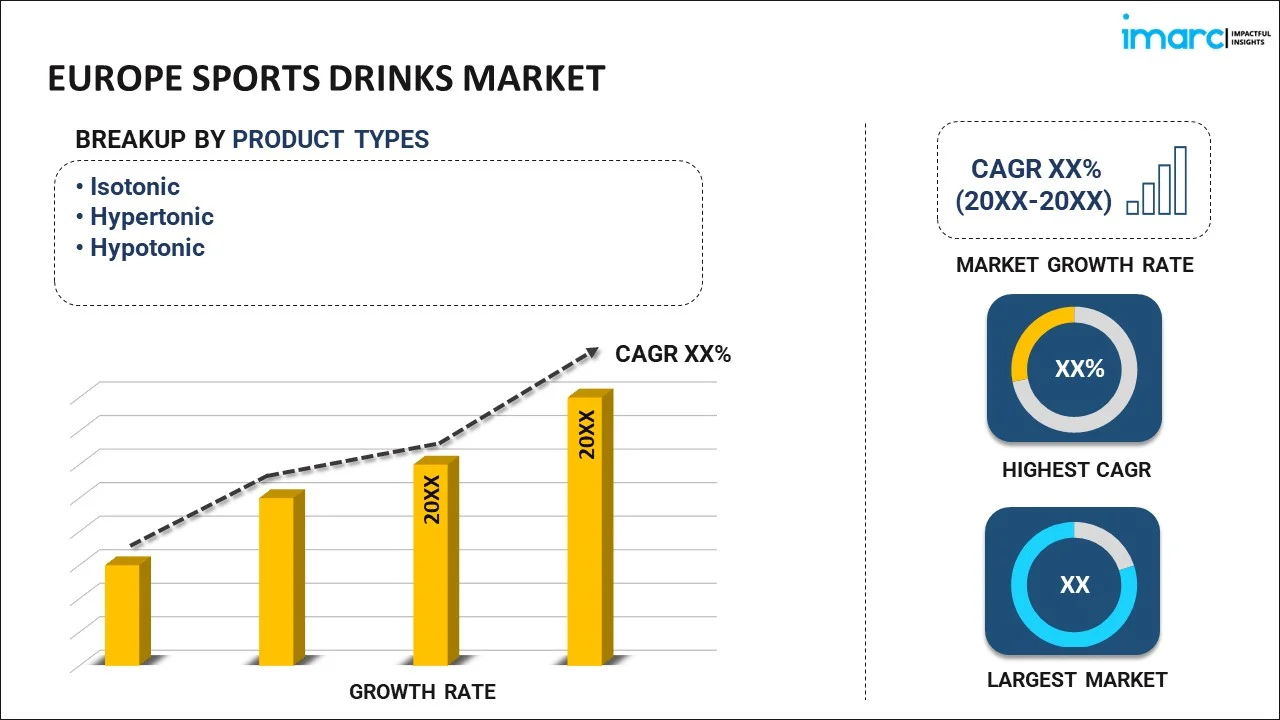
Europe Sports and Energy Drinks Market: Industry Trends, Share, Size, Growth, Opportunity and Forecast 2025-2033
Europe Sports and Energy Drinks Market Size and SHhre:
The Europe sports and energy drinks market size reached USD 26.7 Billion in 2024. Looking forward, IMARC Group expects the market to reach USD 46.5 Billion by 2033, exhibiting a growth rate (CAGR) of 6.4% during 2025-2033.
|
Report Attribute
|
Key Statistics
|
|---|---|
|
Base Year
|
2024
|
|
Forecast Years
|
2025-2033
|
|
Historical Years
|
2019-2024
|
|
Market Size in 2024
|
USD 26.7 Billion |
|
Market Forecast in 2033
|
USD 46.5 Billion |
| Market Growth Rate (2025-2033) | 6.4% |
Sports and energy drinks are water-based beverages consumed while performing physical and sports-related activities. They are rich in carbohydrates, vitamins, minerals, electrolytes and caffeine, which aid in improving the athletic performance. They are also consumed for increasing the overall energy levels, managing body weight and enhancing endurance of the body. These beverages are available in a wide variety of flavors and are used as an alternative to water to hydrate the body and gain the electrolytes lost through sweating during workouts.
The rising health consciousness among the masses, along with the increasing participation in sports and fitness-related activities, is one of the key factors driving the growth of the market. In order to manage their sedentary lifestyles, individuals across Europe are increasingly engaging in high-intensity activities and consuming sports and energy drinks to keep themselves hydrated and energetic. Furthermore, the growing number of fitness and health clubs that offer novel dietary programs and encourage the consumption of these beverages are also contributing to the market growth. Additionally, the launch of exotic flavors, including pineapple, lime, mint, strawberry, cranberry, orange and kiwi, in sugar-free and low calorie variants, are anticipated to drive the market further in the region.
Key Market Segmentation:
IMARC Group provides an analysis of the key trends in each segment of the Europe sports and energy drinks market report, along with forecasts at the regional and country levels from 2025-2033. Our report has categorized the market based on product type, packaging type, distribution channel, type and target consumer.
Sports Drinks Market
Breakup by Product Type:

- Isotonic
- Hypertonic
- Hypotonic
Breakup by Packaging Type:
- Bottle (Pet/Glass)
- Can
- Others
Breakup by Distribution Channel:
- Supermarkets and Hypermarkets
- Convenience Stores
- Online
- Others
Breakup by Country:
- Germany
- France
- United Kingdom
- Italy
- Spain
- Others
Energy Drinks Market
Breakup by Product:
- Alcoholic
- Non-Alcoholic
Breakup by Type:
- Non-Organic
- Organic
Breakup by Packaging Type:
- Bottle (Pet/Glass)
- Can
- Others
Breakup by Distribution Channel:
- Supermarkets and Hypermarkets
- Convenience Stores
- Online
- Others
Breakup by Target Consumer:
- Teenagers
- Adults
- Geriatric Population
Breakup by Country:
- Germany
- France
- United Kingdom
- Italy
- Spain
- Others
Competitive Landscape:
The competitive landscape of the industry has also been examined along with the profiles of the key players.
Key Questions Answered in This Report:
- How has the Europe sports and energy drinks market performed so far and how will it perform in the coming years?
- What has been the impact of COVID-19 on the Europe sports and energy drinks market?
- What are the key regional markets?
- What is the breakup of the market based on the product type?
- What is the breakup of the market based on the packaging type?
- What is the breakup of the market based on the distribution channel?
- What is the breakup of the market based on the type?
- What is the breakup of the market based on the target consumer?
- What are the various stages in the value chain of the industry?
- What are the key driving factors and challenges in the industry?
- What is the structure of the Europe sports and energy drinks market and who are the key players?
- What is the degree of competition in the industry?
Need more help?
- Speak to our experienced analysts for insights on the current market scenarios.
- Include additional segments and countries to customize the report as per your requirement.
- Gain an unparalleled competitive advantage in your domain by understanding how to utilize the report and positively impacting your operations and revenue.
- For further assistance, please connect with our analysts.
 Inquire Before Buying
Inquire Before Buying
 Speak to an Analyst
Speak to an Analyst
 Request Brochure
Request Brochure
 Request Customization
Request Customization




.webp)




.webp)












